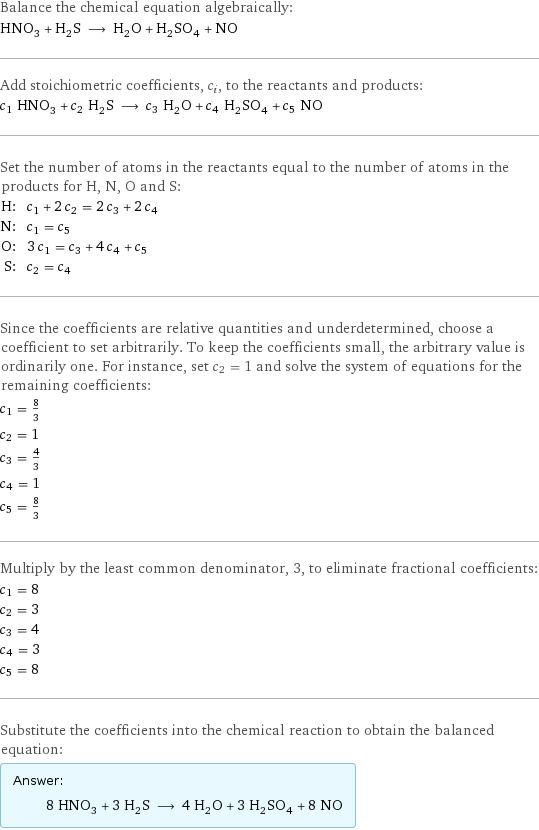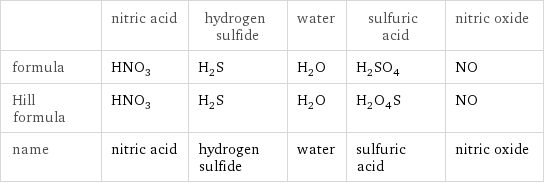Input interpretation

HNO_3 (nitric acid) + H_2S (hydrogen sulfide) ⟶ H_2O (water) + H_2SO_4 (sulfuric acid) + NO (nitric oxide)
Balanced equation

Balance the chemical equation algebraically: HNO_3 + H_2S ⟶ H_2O + H_2SO_4 + NO Add stoichiometric coefficients, c_i, to the reactants and products: c_1 HNO_3 + c_2 H_2S ⟶ c_3 H_2O + c_4 H_2SO_4 + c_5 NO Set the number of atoms in the reactants equal to the number of atoms in the products for H, N, O and S: H: | c_1 + 2 c_2 = 2 c_3 + 2 c_4 N: | c_1 = c_5 O: | 3 c_1 = c_3 + 4 c_4 + c_5 S: | c_2 = c_4 Since the coefficients are relative quantities and underdetermined, choose a coefficient to set arbitrarily. To keep the coefficients small, the arbitrary value is ordinarily one. For instance, set c_2 = 1 and solve the system of equations for the remaining coefficients: c_1 = 8/3 c_2 = 1 c_3 = 4/3 c_4 = 1 c_5 = 8/3 Multiply by the least common denominator, 3, to eliminate fractional coefficients: c_1 = 8 c_2 = 3 c_3 = 4 c_4 = 3 c_5 = 8 Substitute the coefficients into the chemical reaction to obtain the balanced equation: Answer: | | 8 HNO_3 + 3 H_2S ⟶ 4 H_2O + 3 H_2SO_4 + 8 NO
Structures

+ ⟶ + +
Names

nitric acid + hydrogen sulfide ⟶ water + sulfuric acid + nitric oxide
Reaction thermodynamics
Gibbs free energy

| nitric acid | hydrogen sulfide | water | sulfuric acid | nitric oxide molecular free energy | -80.7 kJ/mol | -33.4 kJ/mol | -237.1 kJ/mol | -690 kJ/mol | 87.6 kJ/mol total free energy | -645.6 kJ/mol | -100.2 kJ/mol | -948.4 kJ/mol | -2070 kJ/mol | 700.8 kJ/mol | G_initial = -745.8 kJ/mol | | G_final = -2318 kJ/mol | | ΔG_rxn^0 | -2318 kJ/mol - -745.8 kJ/mol = -1572 kJ/mol (exergonic) | | | |
Entropy

| nitric acid | hydrogen sulfide | water | sulfuric acid | nitric oxide molecular entropy | 156 J/(mol K) | 206 J/(mol K) | 69.91 J/(mol K) | 157 J/(mol K) | 211 J/(mol K) total entropy | 1248 J/(mol K) | 618 J/(mol K) | 279.6 J/(mol K) | 471 J/(mol K) | 1688 J/(mol K) | S_initial = 1866 J/(mol K) | | S_final = 2439 J/(mol K) | | ΔS_rxn^0 | 2439 J/(mol K) - 1866 J/(mol K) = 572.6 J/(mol K) (endoentropic) | | | |
Equilibrium constant
![Construct the equilibrium constant, K, expression for: HNO_3 + H_2S ⟶ H_2O + H_2SO_4 + NO Plan: • Balance the chemical equation. • Determine the stoichiometric numbers. • Assemble the activity expression for each chemical species. • Use the activity expressions to build the equilibrium constant expression. Write the balanced chemical equation: 8 HNO_3 + 3 H_2S ⟶ 4 H_2O + 3 H_2SO_4 + 8 NO Assign stoichiometric numbers, ν_i, using the stoichiometric coefficients, c_i, from the balanced chemical equation in the following manner: ν_i = -c_i for reactants and ν_i = c_i for products: chemical species | c_i | ν_i HNO_3 | 8 | -8 H_2S | 3 | -3 H_2O | 4 | 4 H_2SO_4 | 3 | 3 NO | 8 | 8 Assemble the activity expressions accounting for the state of matter and ν_i: chemical species | c_i | ν_i | activity expression HNO_3 | 8 | -8 | ([HNO3])^(-8) H_2S | 3 | -3 | ([H2S])^(-3) H_2O | 4 | 4 | ([H2O])^4 H_2SO_4 | 3 | 3 | ([H2SO4])^3 NO | 8 | 8 | ([NO])^8 The equilibrium constant symbol in the concentration basis is: K_c Mulitply the activity expressions to arrive at the K_c expression: Answer: | | K_c = ([HNO3])^(-8) ([H2S])^(-3) ([H2O])^4 ([H2SO4])^3 ([NO])^8 = (([H2O])^4 ([H2SO4])^3 ([NO])^8)/(([HNO3])^8 ([H2S])^3)](../image_source/39bb10bafc597c7f88c629a9c6040f89.png)
Construct the equilibrium constant, K, expression for: HNO_3 + H_2S ⟶ H_2O + H_2SO_4 + NO Plan: • Balance the chemical equation. • Determine the stoichiometric numbers. • Assemble the activity expression for each chemical species. • Use the activity expressions to build the equilibrium constant expression. Write the balanced chemical equation: 8 HNO_3 + 3 H_2S ⟶ 4 H_2O + 3 H_2SO_4 + 8 NO Assign stoichiometric numbers, ν_i, using the stoichiometric coefficients, c_i, from the balanced chemical equation in the following manner: ν_i = -c_i for reactants and ν_i = c_i for products: chemical species | c_i | ν_i HNO_3 | 8 | -8 H_2S | 3 | -3 H_2O | 4 | 4 H_2SO_4 | 3 | 3 NO | 8 | 8 Assemble the activity expressions accounting for the state of matter and ν_i: chemical species | c_i | ν_i | activity expression HNO_3 | 8 | -8 | ([HNO3])^(-8) H_2S | 3 | -3 | ([H2S])^(-3) H_2O | 4 | 4 | ([H2O])^4 H_2SO_4 | 3 | 3 | ([H2SO4])^3 NO | 8 | 8 | ([NO])^8 The equilibrium constant symbol in the concentration basis is: K_c Mulitply the activity expressions to arrive at the K_c expression: Answer: | | K_c = ([HNO3])^(-8) ([H2S])^(-3) ([H2O])^4 ([H2SO4])^3 ([NO])^8 = (([H2O])^4 ([H2SO4])^3 ([NO])^8)/(([HNO3])^8 ([H2S])^3)
Rate of reaction
![Construct the rate of reaction expression for: HNO_3 + H_2S ⟶ H_2O + H_2SO_4 + NO Plan: • Balance the chemical equation. • Determine the stoichiometric numbers. • Assemble the rate term for each chemical species. • Write the rate of reaction expression. Write the balanced chemical equation: 8 HNO_3 + 3 H_2S ⟶ 4 H_2O + 3 H_2SO_4 + 8 NO Assign stoichiometric numbers, ν_i, using the stoichiometric coefficients, c_i, from the balanced chemical equation in the following manner: ν_i = -c_i for reactants and ν_i = c_i for products: chemical species | c_i | ν_i HNO_3 | 8 | -8 H_2S | 3 | -3 H_2O | 4 | 4 H_2SO_4 | 3 | 3 NO | 8 | 8 The rate term for each chemical species, B_i, is 1/ν_i(Δ[B_i])/(Δt) where [B_i] is the amount concentration and t is time: chemical species | c_i | ν_i | rate term HNO_3 | 8 | -8 | -1/8 (Δ[HNO3])/(Δt) H_2S | 3 | -3 | -1/3 (Δ[H2S])/(Δt) H_2O | 4 | 4 | 1/4 (Δ[H2O])/(Δt) H_2SO_4 | 3 | 3 | 1/3 (Δ[H2SO4])/(Δt) NO | 8 | 8 | 1/8 (Δ[NO])/(Δt) (for infinitesimal rate of change, replace Δ with d) Set the rate terms equal to each other to arrive at the rate expression: Answer: | | rate = -1/8 (Δ[HNO3])/(Δt) = -1/3 (Δ[H2S])/(Δt) = 1/4 (Δ[H2O])/(Δt) = 1/3 (Δ[H2SO4])/(Δt) = 1/8 (Δ[NO])/(Δt) (assuming constant volume and no accumulation of intermediates or side products)](../image_source/d91cf82b08eb7ac9c1b54ae783ff5c4c.png)
Construct the rate of reaction expression for: HNO_3 + H_2S ⟶ H_2O + H_2SO_4 + NO Plan: • Balance the chemical equation. • Determine the stoichiometric numbers. • Assemble the rate term for each chemical species. • Write the rate of reaction expression. Write the balanced chemical equation: 8 HNO_3 + 3 H_2S ⟶ 4 H_2O + 3 H_2SO_4 + 8 NO Assign stoichiometric numbers, ν_i, using the stoichiometric coefficients, c_i, from the balanced chemical equation in the following manner: ν_i = -c_i for reactants and ν_i = c_i for products: chemical species | c_i | ν_i HNO_3 | 8 | -8 H_2S | 3 | -3 H_2O | 4 | 4 H_2SO_4 | 3 | 3 NO | 8 | 8 The rate term for each chemical species, B_i, is 1/ν_i(Δ[B_i])/(Δt) where [B_i] is the amount concentration and t is time: chemical species | c_i | ν_i | rate term HNO_3 | 8 | -8 | -1/8 (Δ[HNO3])/(Δt) H_2S | 3 | -3 | -1/3 (Δ[H2S])/(Δt) H_2O | 4 | 4 | 1/4 (Δ[H2O])/(Δt) H_2SO_4 | 3 | 3 | 1/3 (Δ[H2SO4])/(Δt) NO | 8 | 8 | 1/8 (Δ[NO])/(Δt) (for infinitesimal rate of change, replace Δ with d) Set the rate terms equal to each other to arrive at the rate expression: Answer: | | rate = -1/8 (Δ[HNO3])/(Δt) = -1/3 (Δ[H2S])/(Δt) = 1/4 (Δ[H2O])/(Δt) = 1/3 (Δ[H2SO4])/(Δt) = 1/8 (Δ[NO])/(Δt) (assuming constant volume and no accumulation of intermediates or side products)
Chemical names and formulas

| nitric acid | hydrogen sulfide | water | sulfuric acid | nitric oxide formula | HNO_3 | H_2S | H_2O | H_2SO_4 | NO Hill formula | HNO_3 | H_2S | H_2O | H_2O_4S | NO name | nitric acid | hydrogen sulfide | water | sulfuric acid | nitric oxide